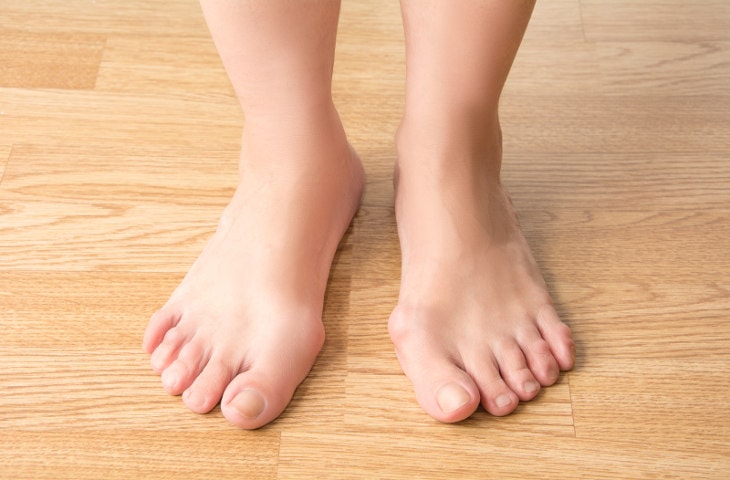Painful and unsightly, bunions usually form a boney, hard bump on the joints of your big toes. If you suffer from bunions, Yeargain Foot & Ankle offers our patients a simple and effective corrective surgery. Patients will be pleased to hear that Dr. Yeargain and Dr. Agyen specialize in minimally invasive and unique cosmetic treatments for bunions. Dr. Yeargain and Dr. Agyen learned and perfected these procedures during their residency rotations in the plastic surgery department at the University of Pittsburgh and the University of Illinois, respectively. During the procedure, Dr. Yeargain and Dr. Agyen can hide the incision on the inside of your foot, which keeps visible postoperative scarring to a minimum. So, if you suffer from painful bunions or suspect you may have one, get in touch with our experienced team at Yeargain Foot & Ankle.
Bunions are commonly known as a bony bump on the joint of your big toe. What many people don’t realize is that bunions are a genetic issue, rather than being caused by environmental factors such as footwear or lifestyle. Once formed, the most effective treatment for bunions is corrective surgery, and Dr. Yeargain specializes in a unique cosmetic treatment for bunions.

FAQs
How do bunions form?
Bone spurs are tiny projections that develop along the edges of a bone. Bunions are a genetic issue caused by your metatarsal bone moving inward. Some patients might have an additional component to a bunion, such as arthritis or a bone spur on top of the joint. Dr. Yeargain can look at the condition both clinically and radiographically during a consultation, and let you know if there any components complicating your condition. If there is a bone spur component or any other, he and his team can adjust your treatment to account for it.
How common are bunions?
Bunions are extremely common. Dr. Yeargain sees them in patients of all ages, from teenagers to the elderly, and all throughout.
Are my shoes giving me bunions?
It’s a common misconception to think bunions are caused by a poor choice of shoe gear or other lifestyle factors. While shoes can exacerbate symptoms of the problem, rubbing against the bony prominence or irritating the skin, bunions are actually a genetic issue. There is nothing that can be done to prevent a bunion and nothing that can reverse it once it has formed. The options are to treat it surgically or accommodate it.
Why do bunions cause pain?
Bunions are caused because a joint is out of alignment. With use, that malaligned joint wears down and becomes irritated. Additionally, the bony prominence caused by this improper alignment can rub and irritate shoes. It can get swollen, sore, and the skin can abrade. It’s usually at this point that patients start to think about fixing a bunion.
Are bunions harmful in the long term?
With a bunion, the joint is out of alignment while operating. This wears down the joint and its cartilage faster than usual. The longer you wait to treat a bunion the more damage can be done to the joint. Dr. Yeargain often advocates for early treatment, as putting it off can result in a more complicated condition, and can also reduce surgical options as the joint wears away.
How can a bunion be treated?
There are two primary treatment options for bunions. Some patients will simply accommodate the bony prominence, modifying their footwear or wearing sandals that don’t rub against the bunion. The other effective option is to undergo surgery to fix the malaligned joint.
Bunions are different from other foot and ankle problems, as there aren’t many effective non-surgical options for treatment. With other foot and ankle problems, Dr. Yeargain works to help patients avoid surgery whenever possible. With bunions, the joint is in a bad position, which wears down the joint over time. Dr. Yeargain will often advocate for surgery sooner rather than later, as it is the most effective option. Also, early treatment keeps the patient from doing more damage to the joint or wearing it down, which can reduce surgical options in the future.
When is it time to have bunion surgery?
Dr. Yeargain asks his patients to answer three questions when they are considering any surgery: 1) Does the condition hurt every day? 2) Does it limit my activity? 3) Does it make decisions for me?
Patients don’t necessarily treat a bunion because it looks bad, but because it has started to affect their lifestyle. Bunions can change the way you live your life, limiting your daily activities (your ability to stand, walk, or exercise) as well as your footwear options. Dr. Yeargain feels that factors affecting your lifestyle shouldn’t be dismissed. He’ll work with you to get you back on your feet and in charge of your life.
What is Dr. Yeargain’s special approach to treating bunions?
Dr. Yeargain studied with the plastics department at the University of Pittsburgh as a part of his medical residency. In addition to specializing in the surgical treatment of bunions, he brings a few cosmetic tricks to the table to minimize visible scarring afterwards. Bunions are traditionally treated via an incision on top of the toe joint, which leaves an unsightly scar. Dr. Yeargain makes his incision on the inside of the foot, so it isn’t visible from the top of the foot. He then closes the incision with a plastic surgery technique he learned during his residency. He uses a special, absorbable suture placed in such a way that there are no stitches going across the incision line. This means there are no suture scars afterwards, just one straight thin line, which is hardly noticeable because it’s on the inside of the foot.
What does bunion surgery involve?
Should you determine surgery is the right option for you, Dr. Yeargain will talk you through the surgical process and recovery. Depending on certain factors, many patients are put to sleep for the procedure. After what amounts to a pleasant nap, they awake to find their bunion gone.
For the surgery itself, Dr. Yeargain gains access to the joint via an incision on the side of the foot. He then shaves down any prominence that exists on the inside of the joint and uses a bone saw to make a v-shaped cut in the bone. This cut allows him to slide the end of the bone over, back into alignment, where it should have been in the first place. With the bone in place, he typically uses a single screw to hold it in place, allowing the bone to heal together in proper alignment. Once the joint is realigned and the bone is healed, there is no longer any bony prominence. Essentially the foot has been narrowed down, and the bunion removed.
How long will I have to take off work to recover from surgery?
Foot surgery is a little different from other surgeries, as gravity and weight-bearing can severely impact the healing process. While some doctors allow patients to get back on their feet after only a week or so following their surgery, Dr. Yeargain has found that being conservative in his post-operative approach yields better results. Keeping patients off their feet allows the joint to heal properly, in the exact position it was meant to, and reduces swelling; the number one complaint after bunion surgery. Patients also tend to notice less pain and a reduced chance of infection.
Dr. Yeargain works with patients to determine a time of year when they can stay off their feet for at least a few weeks, allowing the foot to fully heal by keeping it elevated and out of use. He offers a number of special devices designed to help patients keep off their foot completely. At his online store (TK – store link), patients can find rolling scooters, crutches, special types of walkers, and a variety of other options to help aid the healing process.
How can I prevent bunions?
Bunions are a genetic issue. While there are steps to alleviate symptoms, there’s nothing that can prevent them. Once they’ve developed, the options are to treat them surgically or try to accommodate them.
Should I wear special shoes if I have bunions?
Some patients are able to find shoes that alleviate the symptoms of a bunion. Shoes with a larger toe box can provide room for the bony prominence associated with a bunion. Other patients will wear sandals that don’t have material resting over the large bump. However, this is ultimately a lifestyle issue, as some fields of work or certain activities might require footwear that can exacerbate symptoms. While footwear changes can help reduce pain, surgery is the only way to address the underlying condition.
Are bunions genetic?
Yes, bunions are a genetic issue. They are a joint malalignment caused by the metatarsal bone gradually leaning inward over time.
How are bunions different from bone spurs?
Yes, bunions are a genetic issue. They are a joint malalignment caused by the metatarsal bone gradually leaning inward over time.

